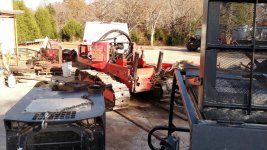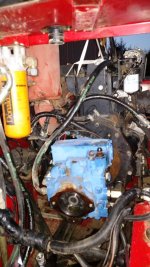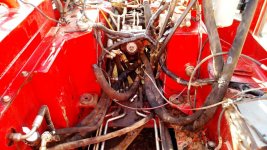For anyone else having to go through this headache of pulling the mulcher pump on the 140, here are a few ideas that might help.
1) Buy lots of JIC caps and plugs from #16 down to #4. I've been purchasing these from
Hydraulic Fittings | Hose Fittings Online Store | Hydraulics Direct for good prices and fast shipping. It's cheaper to drop $200-$300 on plugs and caps than to allow dirt in and wreck your hydraulic system. Cleanliness is everything in hydraulics. Drain the hydraulic tank with an oil filtration cart. Filtering the oil down to 2 microns will allow re-use of the hydraulic fluid.
2) Take the time to remove the overhead oil cooler and cab assemblies. Getting the oil cooler & fan lines out of the way will add a little working room that will make a big difference. Old copper phone main line with multiple color coded wires are great for marking matching hose connections.

3) The engine and main mulcher pump CAN be pulled together without removing the rear sheet metal parts. The engine/pump will need to be rotated 90 degrees once high enough to facilitate removal. Crow's foot wrenches, short box end wrenches and curved distributor wrenches make some of the connectors easier to remove. I did NOT break any of the track drive lines apart - there was no need to open that system and risk contamination the way I did my engine removal. All hoses from the mulcher pump can be removed with the exception of the 2 lines going to the filter - cap and plug those 2 at the filter connections and leave connected at the pump until pump is out of the machine.

4) Be sure to support the track drive and pilot pumps before removing the mulcher pump/engine assembly. A couple of well placed ratchet straps are perfect to hold everything in place. Once enough slack is taken up on the straps, remove the two bolts holding the track drive pump to the mulcher pump and pry apart. Be sure to adjust straps to keep pumps in normal position and then remove engine/mulcher pump assembly.

5) Ensure all caps and plugs are tight on broken open fittings/lines. Take the opportunity to steam/pressure wash anything you have not normally accessed. Make sure there is NO loose dirt to contaminate any hydraulic fluids prior to re-assembly. After flushing hydraulics, wash/steam again just prior to re-assembly.
6) Use an oil filtration cart to flush all potentially contaminated lines, tank and cooler. I use a mixture of mostly diesel fuel with some old hydraulic fluid to flush my lines. I keep my flushing mix in a separate drum just for these occurrences and the filtration cart removes the contamination.
I've priced repairs and new pumps with the Eaton OEM pump from $2k - $7.5k
I currently have a price for a custom built series 90 size 100 pump for $3.5k. My only concern with this is the extra 2" length required BUT I think this will still fit in without changing hoses.:confused3:


